
Prepared on Notepad by Ian Smith, This page created 27th July 2000. Best on 800*600.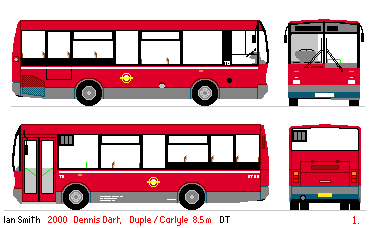
DT, DC: The Duple / Carlyle DartsThe Duple bodied Dennis Dart was the doyen of the family. The superbly modernistic body was envisaged as the sole body for the new chassis, Duple and Dennis both being part of the Hestair group of companies. The combination was first put together in demonstrator form in 1988, but London Buses insisted on a short 8.5metre version in order to make the most of the current financial regime: the DT was born. Duple built the first few bodies for London Buses before being bought by Plaxton. Plaxton did not want the Dartline body and sold the design rights to Carlyle, who continued it without change as the Dartline.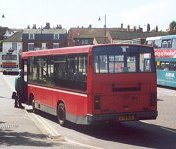
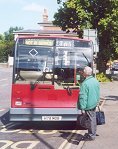

DT78 still wears the basic London Buses livery in June 2000, after two changes of operator. From 1994 to 2000 it was in the care of London United, and has since passed to Coastal Coaches in East Sussex. It is seen here at Rye Station. Photos by Ian Smith. Click for larger versions.1990 was the year of the DT. DT1-27, bodied by Duple, went to the London United subsidiary, operating out of Fulwell and Hounslow garages, creating new routes H21-H23, R69 and R70. They wore Harrier logos on the red, with grey skirts and white tapes at waist level, with London United crests and names on the front, and London Buses roundels mid-way along the sides.
DT28-41, with Carlyle bodies, went to Selkent's low-cost unit at Orpington, to operate Roundabout routes R1 and R11. These wore Roundabout livery: red with grey skirt, but with the white tape at cant-rail level and prominent Roundabout fleetnames. They were for routes R1 and R11, where they took over from Metroriders.
DT42-57 went to the Selkent District at Bromley, wearing red with grey skirts, a white roof tape, and London Buses roundels. These were mainly for the 314, 336, 126 and 396 routes. The 314 replaced the B1, which had vastly outgrown its origins with Ford Strachans microbuses. The 336 was a new back-roads route, serving new areas. The 396 was a minor re-routing of the 126 at the Beckenham end, both routes using the DTs and MetroRiders to replace Nationals and Titans on the 126 with a double-frequency midibus service on the Eltham-Bromley section.
DT58-70 were South London district's contingent for the 412, a new route replacing part of the 12A, operating out of Thornton Heath. Livery was red with grey skirt, with cant-rail tape and small South London fleetnames.
DT71-87: FW: DT88-94: Willesden introduced DTs as Skippers in September 1990, on new route 206. Skippers wore the white tape at waist level, with discrete Metroline fleetnames above the cab and doorway. The Skipper name was on the front, with London Buses roundels on the sides..
DT95-109: Edgware began "Skipper" operation in November 1990, converting the 251 from BL to DT (10), and the 288 from Metrobuses (3). The 251 was Monday-Saturday only, so the DTs were also found on the 240 on Sundays.
Harrow "hoppas" began work from North Wembley in DT110-143, 156-157: NW/HD:
DT144-155: AV: H24/25 shared with MR and FR midibuses
DT158-167: V: ousted Lynxes from 283
But by the end of 1991 Carlyle was in trouble, along with other bus-body builders, and the Dartline production ceased. The design rights passed on to Marshall of Cambridge, who pacified the design somewhat for their ventures into the minibus and SLF marketplace. In serviceThe DT's sojourn in the south-east suburbs of London was relatively short-lived, and the Bromley and Orpington examples were soon to be found in the London United country beside the Thames, west of London, although Selkent district retained a few that were used on the 124 from Catford. 1994 saw the DTs pass to the privatised companies, nearly half of them to London United, a large number to Metroline, and a few to Stagecoach Selkent and South London.London United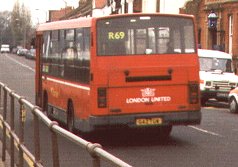
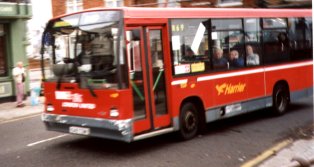
London United Harrier DT42 catches me by surprise as it swoops past on the R69 in Barnes, October 1997. By the state of its fenders, it appears that agility doesn't always keep it out of trouble.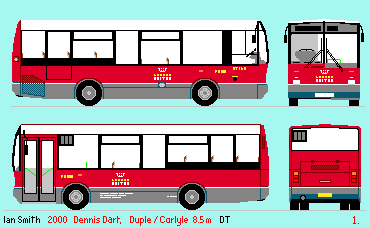 London United acquired all 28 of the Duple-bodied DTs (DT1-27 and DT168),
plus 55 of the Carlyle versions.
Its territory was - and is - the traditional single-decker land around
Kingston, Hounslow, Fulwell and London Airport,
and it put the Darts to intensive use.
Rather than the "Hoppa" name that was appearing on the sides of small buses elsewhere in London,
London United emphasised the agile nature of its new buses with a Harrier name
and symbol. LU claimed an 11% first-year increase in ridership on routes where the Darts took over from double-deckers.
London United acquired all 28 of the Duple-bodied DTs (DT1-27 and DT168),
plus 55 of the Carlyle versions.
Its territory was - and is - the traditional single-decker land around
Kingston, Hounslow, Fulwell and London Airport,
and it put the Darts to intensive use.
Rather than the "Hoppa" name that was appearing on the sides of small buses elsewhere in London,
London United emphasised the agile nature of its new buses with a Harrier name
and symbol. LU claimed an 11% first-year increase in ridership on routes where the Darts took over from double-deckers.
The later repaint into London United's own livery,
with mid-grey skirt and white roof made them even more eye-catching.
DT45 rolls up towards Hammersmith Bridge at the end of an autumn afternoon in October 1997. It sports an air-conditioning pod on the roof, dual-purpose seating, orange rather than green handrails and Toshiba sponsorship advertising but still wears the original bus livery.The little Darts with their wide undivided doorway were found ideal for London United's Heathrow Airport services, especially the direct hotel to airport service. A large number of them were converted to dual-purpose seating, with LARGE luggage racks over the front wheelarches, and fitted with an air-conditioning pod on the roof. Most of the Airbus variants were given a distinctive red and yellow Airbus Direct livery. They were garaged at Heathrow West Ramp, and maintained by Stamford Brook. The Airbus Direct service to hotels ceased in November 1999, and the little buses went to new homes around the UK.Airbus Direct Darts. DT11 swoops round the corner at Aldwych in December 1998, and DT10 makes a more sedate departure from Kings Cross in March 1999.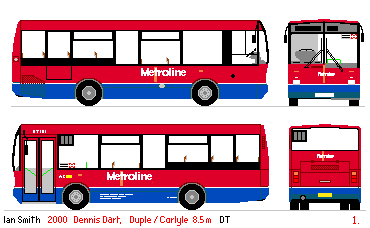
MetrolineMetroline was the next largest recipient of Carlyle Darts, for its suburban network in north-west London, based around Willesden, Cricklewood, North Wembley, Harrow and Edgware. There they were called Skippers. As repainting time came around the Darts gained the attractive red and blue livery.
Metroline began disposal of its Darts in December 1996,
with a sale of six to MTL London to join those newly taken over from R&I.
In 1997 there followed a larger sale of 16 buses to Rossendale Transport in Lancashire,
who already had three Duple bodied versions from 1990.
Another seven rolled their way north to join them in 1998.
Stagecoach Selkent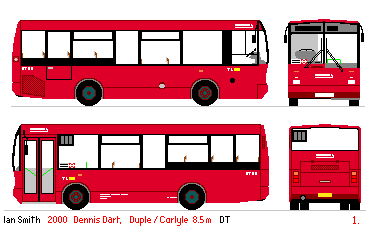 Selkent District, having been an early user of the type in large numbers,
largely lost the work for them before privatisation.
The District lost many of its small-bus routes to Kentishbus (later Londonlinks) and newcomer Metrobus,
and London Buses passed them on to where they were more useful.
Catford did retain an allocation into privatisation, mainly for the 124,
although they were occasionally seen on routes where double-deckers would normally be expected.
Selkent District, having been an early user of the type in large numbers,
largely lost the work for them before privatisation.
The District lost many of its small-bus routes to Kentishbus (later Londonlinks) and newcomer Metrobus,
and London Buses passed them on to where they were more useful.
Catford did retain an allocation into privatisation, mainly for the 124,
although they were occasionally seen on routes where double-deckers would normally be expected.
Some were transferred to Stagecoach Docklands Transit in 1997, in exchange for longer Plaxton-bodied Darts from East London which came to dominate on the 124, gradually usurping them altogether. Stagecoach transferred the DTs away to sunnier climes (Devon General and Red & White) in late 1997.
South London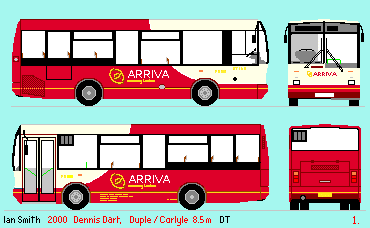 South London Buses inherited the Thornton Heath contingent, the thirteen UGO-registered buses.
Some of the buses acquired "Cowie stripes" - two broad diagonal yellow bands at the rear,
including the seven that were transferred to Leaside in April 1996 for use on Enfield's route 192.
Two more were bought from Metroline .
South London Buses inherited the Thornton Heath contingent, the thirteen UGO-registered buses.
Some of the buses acquired "Cowie stripes" - two broad diagonal yellow bands at the rear,
including the seven that were transferred to Leaside in April 1996 for use on Enfield's route 192.
Two more were bought from Metroline .
The parent company rebranded as Arriva in 1997, and some at least of the South London batch received the "ice-cream scoop red" variant of the livery. Arriva London South passed on some of its DTs to Arriva North-West in early 1999, but brought back the Leaside examples. Some were used on G1, which was sub-contracted to Limebourne complete with buses between September 1999 and April 2000. Others worked from Bedlington Farm in the Croydon area, which took them once more into Bromley on the back-road 367 service (West Croydon - Elmers End - Shortlands - Bromley North). 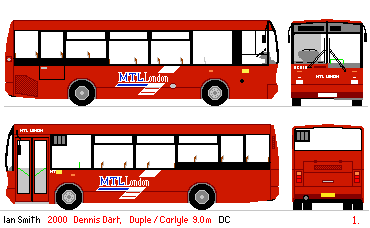
MTL London NorthernMTL London Northern did not start with any of the Carlyle Darts at all. But in October 1995 they took over R&I Tours. With the company they acquired some of the long DC Darts (some had been sold the year before, to Kentish Bus). They bought some of the 8.5m DTs from Metroline at the end of the year, and used those, and other Darts, to operate the 46, 112 and 274.
The Darts were repainted into MTLs dark red with MTL logos.
Several of the short Darts were transferred to Merseyside.
In June 1999 9.0 metre DC216 waits to turn right outside Kings Cross Station on the 46. It seems to be wanting a repaint, as it has lost its MTL logos. Even the legal lettering is not on the red, but on the black modesty panel.
The ShiresLuton & District was eventually given a major rebranding in 1995, emerging as The Shires, with corporate blue, yellow and stone livery, and local fleetnames.The ex-LCNW Darts received the treatment, being branded initially for the 374 of Network watford, but some at least receiving Lucketts of Watford fleetnames after the takeover of that company in 1997. The Cowie group took over in mid 1996, and another rebranding, into national Arriva livery, was decreed at the end of 1997.
Kentish Bus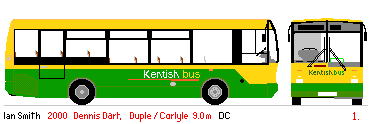 When tender changes reduced R&I's requirement in 1995,
Kentish Bus bought some of the 9.0m Darts.
They were the first buses to receive Kentish Bus's green and yellow livery.
They didn't stay on Thameside for long, soon transferring to other Arriva fleets.
When tender changes reduced R&I's requirement in 1995,
Kentish Bus bought some of the 9.0m Darts.
They were the first buses to receive Kentish Bus's green and yellow livery.
They didn't stay on Thameside for long, soon transferring to other Arriva fleets.
UniversitybusUniversitybus at Hatfield bought two ex-demonstrator 9.8m Darts with Carlyle bodywork for its Hertfordshire network, in 1992. These must have impressed them, as they were precursors of a wider acquisition of Darts with Wright and Marshall bodies in 1995.
Limebourne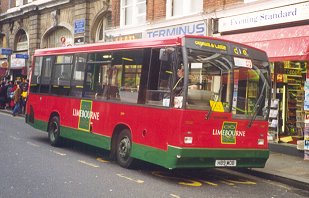
At the end of 1998 Limebourne was in crisis. Parent company Q-Drive went into receivership in October, and the Limebourne management bought the company at the end of November. The companies that leased buses to Limebourne promptly repossessed their leased vehicles, within 24 hours. The new Limebourne (Independent Way) found itself with virtually no buses. But they promptly purchased eleven redundant Darts from Metroline. They went into service in plain red, with Metroline fleetnames still in place, but soon acquired Limebourne's green skirts and fleetnames. Strangely, the Limebourne fleet were given names rather than fleet numbers. Limebourne's DT89 at Victoria Station in March 1999.Connex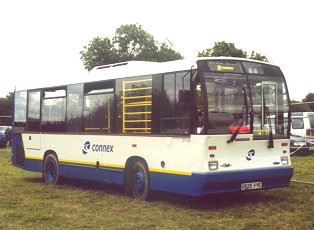
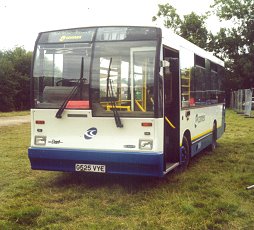
DT25 operated the connection between Lingfield Show and Godstone Station on Sunday 3rd August 2000.
Sullivan BusesSullivan bought DT4 in 2000, and have kept it ever since. At times it has been used in normal service, such as on Hertford's 388, and at other times on Railway Replacement services.DT4 at Hertford Bus Station on the 388, June 2003, and on Railway Replacement, Hertford North Stn, June 2002.1999 and 2000 saw the DTs largely replaced in the London fleets as new short low-floor Mini-Pointer Darts have become available. They didn't go for scrap. Ten year old buses of this quality still had considerable market value. They were dispersed to other fleets of the larger companies, to places where London Buses tender requirements for low-floor doorways do not reach. Others were sold to independents throughout Britain, so their distinctive shape could crop up anywhere to surprise you. They STILL look futuristic. Some operators were chary about the windscreens, having heard tales of expensive garage shunts, and some DTs received new Pointer-style fronts (at a cost of about £30,000) before taking up new appointments. What a shame.
Dart Links:
|
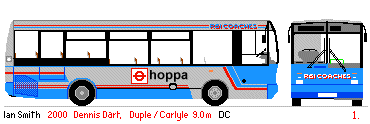 Meanwhile another operator was making an appearance.
R&I Tours of North London won tenders to operate the C11 and C12 with new Darts,
and chose a longer 9.0m version, with bodies started by Duple and completed by Carlyle.
These buses appeared in a very non-London livery of silver-grey and blue (no 80% rule then),
and were soon a familiar sight around Kings Cross.
Meanwhile another operator was making an appearance.
R&I Tours of North London won tenders to operate the C11 and C12 with new Darts,
and chose a longer 9.0m version, with bodies started by Duple and completed by Carlyle.
These buses appeared in a very non-London livery of silver-grey and blue (no 80% rule then),
and were soon a familiar sight around Kings Cross.
 In the Watford area London Country North-West also won an LT tender on the 258,
for which it bought eight even longer Dart Carlyles, with 9.8 metre bodies.
These had a destination box perched on the front,
somewhat spoiling the clean lines, and were finished in LCNW's dull green and grey livery.
In the Watford area London Country North-West also won an LT tender on the 258,
for which it bought eight even longer Dart Carlyles, with 9.8 metre bodies.
These had a destination box perched on the front,
somewhat spoiling the clean lines, and were finished in LCNW's dull green and grey livery.

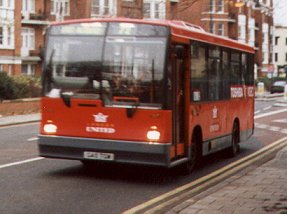

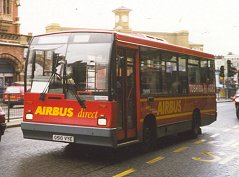
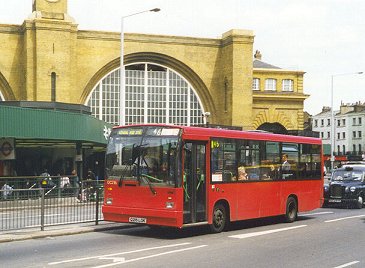


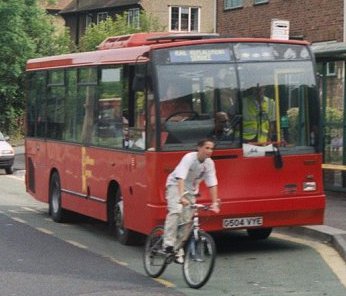
 Bus Stop
Bus Stop Darts
Darts DT
DT histories
histories